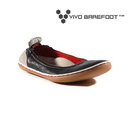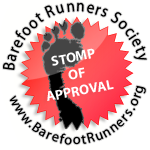|
Check out this quick video on barefoot running produced by the local Los Angeles ABC affiliate!
0 Comments
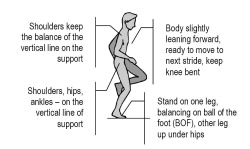 At the beginning of 2009, I started looking around for a more efficient and healthy way to move, which first led me to barefoot types of shoes, like Vivo Barefoot and Vibram FiveFingers. During my internet searches, I stumbled upon a link to PoseTech.com, which promised a way to reduce running injuries through an extremely efficient technique. Dr. Nicholas Romanov, creator of the Pose method, asked why people were taught how to play basketball and football, throw shotput, and play other sports, but were never taught how to run. He believes there is a proper technique that can be used to run. The existing technique of landing on the heel and then pushing off into a wide stride is just as inefficient as a new runner going out there and doing what feels natural. Over 50 percent of runners get injured every year, and a third of those are knee joint injuries. Even with the "advances" in the shoe industry, the injury rates have remained consistent over the past 25 years. Obviously, "just running" is not working for many people. The Pose method looks at running as a technical skill of movement, and believes it should be taught like one, with its own theory, rules, practice exercises, and more. Aerobic conditioning can only take you so far: an efficient movement is necessary to achieve maximal speed and distance. Pose breaks running down into three simple parts: the running pose, the fall, and the pull. Pose --> Fall --> Pull. Even simpler, all you have to do to run is to change support from one leg to the other by pulling the support foot from the ground. It sounds quite simple, but it takes a lot of practice to retrain your muscle memory to learn the movement, and to unlearn old habits. The four forces acting up on the body in movement are gravity, muscle elasticity, ground reaction, and muscle contractions. These forces drive the body forward when they are unbalanced. The runner must create a constant state of unbalance to allow the gravity force to drive the body forward. Running comes down to the level of skill of the runner to interact with gravity throughout the gait cycle, and use the gravity to move forward. To break balance and fall forward, the weight of the body must be on the ball of the foot (BOF) exactly like in barefoot running. Landing on the toes or the heel is not as efficient as a BOF landing, and this may be one of the biggest adjustments for runners practicing the Pose method. While it may be difficult to master, running in the Pose technique is quite simple. Your main goal, besides Pose-->Fall-->Pull, is to get your own body out of its way, and let gravity do all the work. Here are a list of errors that occur from either trying too hard or from incorrect form. And remember, pain is the body's reminder that you're doing something wrong, so don't ignore what your feet and joints are telling you. Running Errors
All information was taken from the "Pose Method of Running" book or a clinic manual, both written by Dr. Nicholas Romanov. I highly recommend checking out the book and the articles and discussions on Posetech.com for more information. I also highly suggest attending a clinic with a certified coach to ensure you're properly running using the Pose method. I recently heard about the MECA back wedge, an exercise device designed to reverse spinal damage due to sitting, by bending the spine back into its natural shape. By following their "Back Protocol", users of the wedge "will prevent degenerative breakdown of joints and discs and help to maintain a healthy, functional spine." The concept sounds amazing, as I for one have occasional back pain due to sitting for hours upon hours in a supposedly ergonomic Herman Miller chair.
With 85% of the population experiencing back pain at some point in their lives, it's important for us to be aware of the problem and way to prevent it. Stretching, whether by yoga, on a rack, or with a foam roller, it quite important, but sometimes it isn't enough. We need to strengthen our back muscles, as well as the opposing muscles, the abdominals. This back wedge ensures that we do the exercises in a safe way, so that we don't accidentally injure ourselves while we're trying to to heal ourselves. The quick slideshow on the website explain that chairs and a sedentary lifestyle are the primary causes of back pain, as they cause "creep." Creep is the elongation of tissue beyond its intrinsic extensibility resulting from a constant load over time. Creeping gradually lengthens and weakens the spinal soft tissues, which are the ligaments, disc, tendon, fascia, and muscle. Our lumbar curve flattens over time, leading to stiffness, disc herniation, arthritis, and other problems. The MECA back wedge helps increase elasticity in the hips, passively extends the spine, and strengthens the core. While I am intrigued by the device and the logic behind it, I don't think it's worth the price tag of $65.99. I'm going to try to experiment at the gym with a free alternative, and be sure to let you know what works and what does not. If any of you decide to buy one, please let me know what you think and if it helps to alleviate your pain. More and more barefoot running articles keep coming out, so much so that's it's getting a tad ridiculous. They all pretty much repeat the same story, but each newspaper feels they have to cover it since it's such new and exciting news (to some of us.) After today, I will only be posting the most interesting and new tidbit to get published in the major newspapers or national publications. No more hackneyed stories from the "Tuskaloosa Daily" or the "Euguene Encounter" (both I just made up on the spot, but they do sound believable, don't they?).
The first article was shown to me by Mr. Jason P., triathlete and future barefoot runner (maybe.) It was published on Lifehacker.com, which is actually a really cool site. They post about random tips and unorthodox ideas, and have an affiliation with Gizmodo, a unique gewgaw site. The story just repeats things already talked about here, like Dan Lieberman's barefoot running study, but it's worth checking out the rest of the website to get a different viewpoint from which to look at the world. The second article is from Yahoo! News, and is titled "Running Shoes Changed How Human Run." Again, there is nothing new in this article - it just summarizes Dan Lieberman's research. The best part of the article comes right at the beginning though: When you strap on a typical running shoe, you may be fighting evolution. Modern-day running shoes have changed the way people run, altering our gait from that of barefoot running - the manner by which people ran for thousands of years before the arrival of the cushioned shoes found on store shelves today - a new study suggests. I'm curious to see how long barefoot running remains in the news after the fallout from the study settles down, but I do hope the news sparks some interest in the average runner and helps them make running more fun, more safe, and a better workout. My mom recently forwarded me an article from ABC News about the ever growing barefoot movement called "Barefoot Running: Is Going Shoe-Free for You?" (Personally, it's the only way I can run without pain.) The article talks about the same issues as all the other articles, like how running barefoot is a growing trend, how there are new shoes companies like Vibram Five Fingers, Vivo Barefoot, and Feelmax that are catering to the alternative runners, how there have been no true scientific studies but how there is plenty of anecdotal evidence that barefoot running is a healthier way to run. I highly recommend reading the article for yourself, but allow me to quote a couple of the more important passages.
Barefoot Ted McDonald, one of the unofficial spokesmen of barefoot running, said, "Once you take off your shoe, you no longer pound the ground," said McDonald. "My way of approaching it is getting people to run more like dancers move across the stage -- with form and grace and strength." Detractors of barefoot running, like shoe store owners, like Michael Gotfredson, founder and "chief runner" of Road Runner Sports, are calling barefooters crazy, saying, "The barefoot running thing is an injury waiting to happen. Ever walked on the beach or a sidewalk and seen shards by the dozens? Don't step on those if you plan on running in your future." It is definitely possible to step on glass and get a cut, especially if your run with your eyes closed. To minimize the risk, barefoot runners must be aware of their surroundings and look for dangerous materials on the ground. And honestly, the guy makes it seem that the roads are paved with broken glass, which isn't even close to the truth. I think it's hilarious how he can't even speak of the benefits of barefoot or minimalist running, as that would put him out of business. If he was smart, he'd hedge his shoe store by selling minimalist shoes like VFF's, to get on the train before it passes him by. Instead, like many stubborn running store owners, he'll probably stick his fingers in his ears and hope the whole thing goes away. Good luck with that. Many of these barefoot running articles that have been coming out now are citing research done by Dr. Daniel Lieberman, professor of human evolutionary biology at Harvard. The study is conveniently layed out on a webpage titled "Running Barefoot or in Minimalist Footwear" and is a great way for newbies or people interested in an alternative type of running to get a start and feel comfortable with the idea. Each page is very clear, using simple writing, pictures, and videos to aid the reader into understanding the barefoot revolution. Our ancestors used to run to chase down food, like gazelles and antelope, which means we were born to run (kind of like the book "Born to Run"). Running is a good thing, even though about 30% of runners get injured every year. When the popularity of running exploded in the 1970's, new shoe companies like Nike tried to solve this problem and make the experience more comfortable by introducing shoes with lots of cushion, which in theory absorbed the shock of the ground impact. The cushy heel, however, caused runners to change their gait, creating a population of heel strikers. The heel absorbed the impact from the foot, but transferred the shock up the leg to the knees and back, creating an all new problem. Heel striking was never an option for runners before this new age of shoes, but now about 75% of the population are doing it. Runners are basically forced to heel strike in modern shoes, unless they excessively point their ankle downward, because the elevated heel catches the ground before the foot reaches a nearly flat clearance point. Barefoot running is gentler on the joints, as the weight should be centered over the hip upon impact, thus evenly distributing the force. There's also a YouTube video which you can watch here: For more information, check out the birthdayshoes.com analysis of the study by Justin Owings. And if you'd like to start barefoot running, but need a little confidence boost or running partner, head over to barefootbenny.com!
|
Barefoot Benny
Barefoot Benny's blog provides both clients and fitness enthusiasts great fitness tips, barefooting news, and nutritional facts throughout the week! Archives
May 2017
Categories
All
|

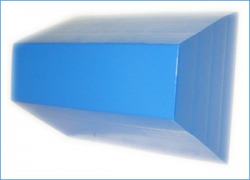
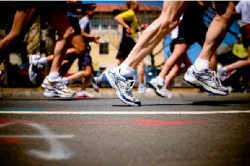
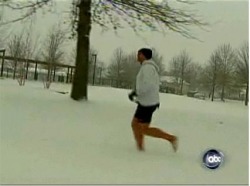

 RSS Feed
RSS Feed


